The Trinity-St. Sergius Lavra: Architectural Ensemble,
Pages of History (14th – 18th cc.) (page 2)
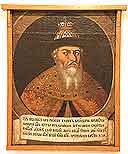 In the 16th century, the Monastery became an important economic and political center. Ivan the Terrible often came here. The Museum presents his portrait, painted in the 18th century according to the chronicle description of the appearance of Ioann Vasilyevich, a tyrant tsar who had “ a incurved nose, fiery eyes and a wild temper”.
In the 16th century, the Monastery became an important economic and political center. Ivan the Terrible often came here. The Museum presents his portrait, painted in the 18th century according to the chronicle description of the appearance of Ioann Vasilyevich, a tyrant tsar who had “ a incurved nose, fiery eyes and a wild temper”.
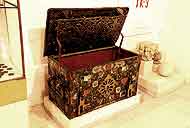 Items of foreign origin demonstrate developed trade relations of the Monastery. The forged safe chest, displayed in the third hall, was brought from Western Europe. It has two locks (a secret functional lock and an external decoration). The safe chest was used to keep money and documents.
Items of foreign origin demonstrate developed trade relations of the Monastery. The forged safe chest, displayed in the third hall, was brought from Western Europe. It has two locks (a secret functional lock and an external decoration). The safe chest was used to keep money and documents.
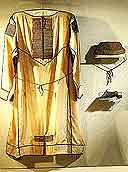 The model and graphic reconstructions in the second hall illustrate the development of the Monastery ensemble in the 16th – 17th century and the construction of a formidable fortress. The Monastery received donations for the right to be buried on the Monastery ground. At the time of troubles in the early 17th century, Tsar Boris Godunov was buried here together with the members of his family. The archeological works revealed their belongings – a leather shoe of Tsarina Xenia, an extremely shabby bonnet of Tsarina Maria and a fragment of a silk shirt of Tsarevich Feodor. These items could be displayed only after delicate restoration accomplished by M.P. Ryabova.
The model and graphic reconstructions in the second hall illustrate the development of the Monastery ensemble in the 16th – 17th century and the construction of a formidable fortress. The Monastery received donations for the right to be buried on the Monastery ground. At the time of troubles in the early 17th century, Tsar Boris Godunov was buried here together with the members of his family. The archeological works revealed their belongings – a leather shoe of Tsarina Xenia, an extremely shabby bonnet of Tsarina Maria and a fragment of a silk shirt of Tsarevich Feodor. These items could be displayed only after delicate restoration accomplished by M.P. Ryabova.
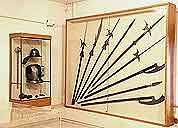 Various exhibits: documents, portraits, paintings and drawings illustrating different episodes of “the Trinity defense”, demonstrate heroism of the Monastery defenders during the siege of Polish and Lithuanian invaders in 1608 – 1610. There are also interesting types of cold arms: pricking and cutting arms (poleaxes, axes, broadswords), striking weapons (bludgeons), defensive armor (cuirasses, chain mail, helmets), catapulting thorns known as “the Trinity garlic”. The Monastery withstood the siege that lasted 16 months thanks to its brave defenders and set an example of courage for the whole Moscow state.
Various exhibits: documents, portraits, paintings and drawings illustrating different episodes of “the Trinity defense”, demonstrate heroism of the Monastery defenders during the siege of Polish and Lithuanian invaders in 1608 – 1610. There are also interesting types of cold arms: pricking and cutting arms (poleaxes, axes, broadswords), striking weapons (bludgeons), defensive armor (cuirasses, chain mail, helmets), catapulting thorns known as “the Trinity garlic”. The Monastery withstood the siege that lasted 16 months thanks to its brave defenders and set an example of courage for the whole Moscow state.
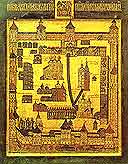 When the siege was released, generous donations permitted to reconstruct and to glorify the Monastery quickly. The Monastery of the mid-17th century was depicted in a rare icon painted at that time. Apart from the cathedrals and churches, tsar palace and tsarina chambers, monk cells and fortification the icon reflected the ice houses, gardens, wells, cellars, kitchen and armory chambers proving a good organization of the Monastery economy.
When the siege was released, generous donations permitted to reconstruct and to glorify the Monastery quickly. The Monastery of the mid-17th century was depicted in a rare icon painted at that time. Apart from the cathedrals and churches, tsar palace and tsarina chambers, monk cells and fortification the icon reflected the ice houses, gardens, wells, cellars, kitchen and armory chambers proving a good organization of the Monastery economy.
|


